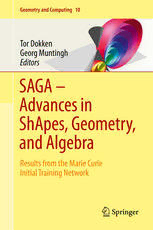
SAGA – Advances in ShApes, Geometry, and Algebra: Results from the Marie Curie Initial Training Network PDF
Preview SAGA – Advances in ShApes, Geometry, and Algebra: Results from the Marie Curie Initial Training Network
Geometry and Computing 10 Tor Dokken Georg Muntingh Editors SAGA – Advances in ShApes, Geometry, and Algebra Results from the Marie Curie Initial Training Network Geometry and Computing 10 SeriesEditors HerbertEdelsbrunner LeifKobbelt KonradPolthier EditorialAdvisoryBoard Jean-DanielBoissonnat GunnarCarlsson BernardChazelle Xiao-ShanGao CraigGotsman LeoGuibas Myung-SooKim TakaoNishizeki HelmutPottmann RobertoScopigno Hans-PeterSeidel SteveSmale PeterSchröder DietrichStoyan Moreinformationaboutthisseriesat http://www.springer.com/series/7580 Tor Dokken (cid:129) Georg Muntingh Editors SAGA – Advances in ShApes, Geometry, and Algebra Results from the Marie Curie Initial Training Network 123 Editors TorDokken GeorgMuntingh SINTEFICT Oslo Norway ISSN1866-6795 ISSN1866-6809(electronic) ISBN978-3-319-08634-7 ISBN978-3-319-08635-4(eBook) DOI10.1007/978-3-319-08635-4 SpringerChamHeidelbergNewYorkDordrechtLondon LibraryofCongressControlNumber:2014953535 MathematicsSubjectClassification(2010):13P25,14Q10,65D17,65D18,65D07,(13D02),41A10, 49M99,65M60,65N30 ©SpringerInternationalPublishingSwitzerland2014 Thisworkissubjecttocopyright.AllrightsarereservedbythePublisher,whetherthewholeorpartof thematerialisconcerned,specificallytherightsoftranslation,reprinting,reuseofillustrations,recitation, broadcasting,reproductiononmicrofilmsorinanyotherphysicalway,andtransmissionorinformation storageandretrieval,electronicadaptation,computersoftware,orbysimilarordissimilarmethodology nowknownorhereafterdeveloped.Exemptedfromthislegalreservationarebriefexcerptsinconnection with reviews or scholarly analysis or material supplied specifically for the purpose of being entered and executed on a computer system, for exclusive use by the purchaser of the work. Duplication of this publication or parts thereof is permitted only under the provisions of the Copyright Law of the Publisher’slocation,initscurrentversion,andpermissionforusemustalwaysbeobtainedfromSpringer. PermissionsforusemaybeobtainedthroughRightsLinkattheCopyrightClearanceCenter.Violations areliabletoprosecutionundertherespectiveCopyrightLaw. Theuseofgeneraldescriptivenames,registerednames,trademarks,servicemarks,etc.inthispublication doesnotimply,evenintheabsenceofaspecificstatement,thatsuchnamesareexemptfromtherelevant protectivelawsandregulationsandthereforefreeforgeneraluse. While the advice and information in this book are believed to be true and accurate at the date of publication,neithertheauthorsnortheeditorsnorthepublishercanacceptanylegalresponsibilityfor anyerrorsoromissionsthatmaybemade.Thepublishermakesnowarranty,expressorimplied,with respecttothematerialcontainedherein. Coverillustration:HeidiE.I.Dahl Printedonacid-freepaper SpringerispartofSpringerScience+BusinessMedia(www.springer.com) Preface SAGA – ShApes, Geometry and Algebra – was a Marie Curie Initial Training Network (ITN) organizedfrom 2008 to 2012 and intended to offer researchers in thefirst fiveyearsoftheircareerstheopportunityto improvetheir researchskills, joinestablishedresearchteamsandenhancetheircareerprospects. As a common requirement in an ITN, researchers were usually expected to exhibittransnationalmobility,i.e.,movefromonecountrytoanother.Inadditionto crossing geographicborders, SAGA offered mobility between the closely related, but nearly disjoint, scientific communities of Geometric Modeling and Algebraic Geometry. Projects funded by the European Union have played a central part in bridgingthe gap betweenthese communities,with the first steps taken from 2001 to 2005in the Fifth FrameworkFutureand EmergingTechnologiesprojectGAIA – Intersection Algorithms for Geometry-based IT, which utilized approximate algebraicmethods. Foryoungandseasonedresearchersalike,SAGAhasofferedaninspiringvenue for exchanging ideas and forming new connections for cooperation. The young researchers of SAGA have not only established relations with researchers at their own institutions, but also with researchers at other institutions working in their fieldofinterest,throughthesecondmentstootherpartnersandparticipationinthe workshops and events. That being said, the most important aspect for the future careers of these young researchers is most likely the basis for future cooperation andresearchtheyhaveestablishedamongthemselves. This book provides insights into research conducted in the SAGA ITN and represents its long-term documentation. It consists of an introduction and 14 chapters,dividedintofourpartsaccordingtotheworkpackagesintheSAGAITN, andwrittenbyacombinationofyoungandestablishedresearchers. Theeditorsaregratefultothereviewersfortheirreports,whichmadeitpossible to select chapters suitable for publication and to improve them considerably. In addition,wewouldliketothanktheleadscientistsfortheircontinuingdevotionto SAGA.SpecialthanksgotoEwaldQuak,forhiscentralroleintheorganizationof eventsandensuringqualitythroughout.Wewouldalsoliketoexpressourgratitude v vi Preface toallexternalcontributors,amongwhomTomGrandinedeservesspecialmention forhisexcellenttalksattheeventsconnectingmathematicstotheindustry.Finally, we would like to thank Springer, in particular Martin Peters and Ruth Allewelt, for the pleasant and smooth cooperation in preparing this volume. The research leadingtothesefindingswassupportedbyfundingfromtheEuropeanCommunity’s Seventh Framework Program under grant agreement no. PITN-GA-2008-214584- SAGA. Oslo,Norway TorDokken May2014 GeorgMuntingh Contents 1 IntroductiontoShApes,Geometry,andAlgebra ....................... 1 TorDokkenandGeorgMuntingh 1.1 Motivation............................................................ 1 1.2 TheSAGAInitialTrainingNetwork................................ 2 1.3 APreviewofThisBook ............................................. 4 References.................................................................... 7 PartI ChangeofRepresentation 2 NumericalMethodsforImplicitisationandTheirApplications ...... 11 OliverJ.D.Barrowclough 2.1 Introduction........................................................... 11 2.2 Implicitisation Methodsfor Low Degree Planar RationalCurves ...................................................... 13 2.2.1 LinesinthePlane........................................... 13 2.2.2 RationalQuadraticBézierCurvesinthePlane ........... 14 2.2.3 RationalCubicBézierCurvesinthePlane................ 15 2.2.4 RationalBézierCurvesofHigherDegree................. 16 2.3 NumericalMethodsforImplicitisationof Higher DegreeCurves,SurfacesandHypersurfaces........................ 18 2.3.1 A General Method for Implicitisation andApproximationUsingLinearAlgebra................ 19 2.3.2 ApproximateImplicitisation............................... 20 2.3.3 InterpolationandApproximationofPointData........... 22 2.3.4 SparseImplicitisation ...................................... 24 2.4 ImplicitisationofEnvelopeCurves,Surfaces andHypersurfaces.................................................... 25 vii viii Contents 2.5 ApplicationsofMethodsforImplicitisation........................ 26 2.5.1 IntersectionAlgorithmsinComputerAidedDesign...... 26 2.5.2 RenderingCurvesandSurfaces............................ 30 2.5.3 Robotics..................................................... 33 References.................................................................... 35 3 SparseImplicitizationviaInterpolation ................................. 39 IoannisZ.Emiris,TatjanaKalinka,andChristosKonaxis 3.1 Introduction........................................................... 39 3.2 ImplicitizationReducedtoElimination............................. 41 3.3 AlgorithmandImplementation...................................... 44 3.3.1 MultidimensionalKernel................................... 46 3.3.2 BernsteinBasis ............................................. 47 3.3.3 ComparisonstoOtherMethods............................ 48 ConclusionandFutureWork................................................ 49 References.................................................................... 50 4 The Intersection Problems of Parametric Curves andSurfacesbyMeansofMatrix-BasedImplicitRepresentations... 53 ThangLuuBa 4.1 Introduction........................................................... 53 4.2 MatrixBasedImplicitRepresentationsofParametricSurfaces.... 54 4.2.1 ConstructionofMatrixRepresentations................... 54 4.2.2 PointsonSurfaceandInversionProblem ................. 57 4.3 Curve/SurfaceIntersection........................................... 58 4.3.1 Linearization of a PolynomialMatrix intheMonomialBasis ..................................... 59 4.3.2 ExtractingtheRegularPartofaNon-square PencilofMatrices .......................................... 60 4.4 Surface/SurfaceIntersection......................................... 63 4.5 Matrix-BasedImplicitRepresentationsofParametric CurvesinSpace ...................................................... 67 4.5.1 ConstructionoftheRepresentationMatrix................ 67 4.5.2 PointsonCurvesandInversionProblems................. 69 4.5.3 RankofaRepresentationMatrixataSingularPoint..... 71 4.5.4 Curve/CurveIntersection................................... 72 Conclusion ................................................................... 72 References.................................................................... 73 PartII GeometricComputing:AlgebraicTools 5 SingularZerosofPolynomialSystems................................... 77 AngelosMantzaflarisandBernardMourrain 5.1 Introduction........................................................... 77 5.2 PreliminaryConsiderations.......................................... 79 5.2.1 IsolatedPointsandDifferentials........................... 80 5.2.2 QuotientRingandDualStructure ......................... 82 Contents ix 5.3 ComputingLocalRingStructure.................................... 85 5.3.1 Macaulay’sDialyticMatrices.............................. 86 5.3.2 IntegrationMethod ......................................... 87 5.3.3 ComputingaPrimal-DualPair............................. 88 5.4 DeflationofaSingularPoint ........................................ 92 5.4.1 TheUnivariateCase........................................ 92 5.4.2 DeflationUsingtheDialyticApproach.................... 93 5.4.3 DeflationUsingtheInverseSystem ....................... 95 5.5 ApproximateMultiplePoint......................................... 98 5.6 Experimentation...................................................... 100 References.................................................................... 102 6 PlaneMixedDiscriminantsandToricJacobians ....................... 105 AliciaDickenstein,IoannisZ.Emiris,andAnnaKarasoulou 6.1 Introduction........................................................... 105 6.2 PreviousWorkandNotation......................................... 108 6.3 AGeneralFormula................................................... 112 6.4 TheMultiplicativityoftheMixedDiscriminant.................... 118 ConclusionandFutureWork................................................ 120 References.................................................................... 120 7 Topology of the Intersection of Two Parameterized Surfaces,UsingComputationsin4DSpace ............................. 123 StéphaneChauandAndréGalligo 7.1 Introduction........................................................... 123 7.1.1 InterestoftheProblem..................................... 123 7.1.2 An Example of Biquadratic Meshing ofaProceduralSurface..................................... 124 7.1.3 OrganizationofthePaper .................................. 126 7.2 PreviousWorkonTopologyComputationofaCurve.............. 126 7.2.1 IsotopicCurve .............................................. 126 7.2.2 RegularityTestandSubdivisionMethod, theCaseofaPlaneCurve.................................. 127 7.2.3 NoLoopandSingleComponent........................... 128 7.3 Topologyof(Parameterized)Surface/SurfaceIntersection ........ 128 7.3.1 Equations.................................................... 128 7.3.2 Topologyofa4DimensionalImplicitCurve (RegularityCriterion) ...................................... 129 7.4 AlgorithmsandDataStructures..................................... 135 7.4.1 HextreeDataStructureandTopology ..................... 135 7.4.2 SubdivisionAlgorithm ..................................... 136 7.4.3 ConnectedComponentsandLoops........................ 137 7.5 TopologyinR3 ....................................................... 138 7.5.1 OneCurveBox ............................................. 139 7.5.2 NodeandDiscretization.................................... 140 7.5.3 Examples.................................................... 142
